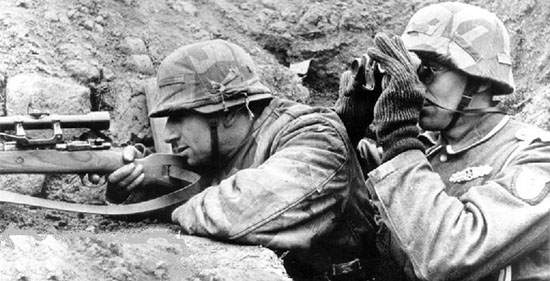|
Reproduction German Awards
All awards we carry are good quality copies, perfectly adequate for living history. Exact, "museum quality" copies also exist- however, they are not $20. They cost hundreds, sometimes thousands of dollars. Those are made as counterfeits with the intention of deceiving buyers. So, when people get snotty because our $30 Knight's Crosses aren't solid sterling silver with silk ribbons...
|
|
-

The Knight's CrossThe Ritterkreuz was the highest award for valor in the German military. Most were awarded to officers for the success of their units in combat, but it could also be earned by personnel of any rank for acts of extreme bravery in battle. Repeated successes were rewarded with subsequent awards attached to the Knight's Cross. In order or precedence they were oak leaves, swords, and diamonds. There were only 27 recipients of the diamonds making it a rather rare award.
There were two grades higher than the diamonds, but only one of each was ever awarded during the War. Hans-Ulrich Rudel was awarded golden oakleaves, and Hermann Goring had the oversized Grand Cross awarded to himself.
Field Note: Many soldiers wore an Iron Cross 2nd class with a neck ribbon in combat and kept their Knight's Crosses at home.
Original Knight's Crosses are made from silver and can fetch well over $10,000. These reproductions are of good but are not "museum" (aka counterfeit) quality. High quality, three-piece silver reproductions exist, but they cost several hundred dollars and the difference is not discernible except on very close examination.
-
Iron CrossesThe Iron Cross was created in 1813 and awarded in all of Germany's conflicts through WWII. It was awarded for bravery or success in battle and could be earned by soldiers of all ranks and branches. The first grade was the Iron Cross 2nd Class- the medal itself was only worn on the day it was given. Afterwards, only the ribbon was worn on the field uniform. Winners of the Iron Cross 2nd Class were then eligible for the first class for further actions. The 1st Class was worn on the left breast of the uniform.
Troops who had won either grade in WWI were authorized to wear it on their uniform during the Second World War. For subsequent awards in WWII, the winners of the 2nd Class would add a "1939 Spange" to their buttonhole ribbon and for the 1st Class they received a modified cross with a Spange cast on top.
Further actions could be recognized with a Knight's Cross or the German Cross in Gold.
-
-
-
Close Combat Clasps
(Nahkampfspange in German) This award was instituted on 25 November 1942 to recognize troops who had participated in close quarters fighting. All troops of all services were eligible. To qualify, all engagements had to be documented and verified by the division. More than one battle could also take place on a given day. In November 1944, Goring created a Luftwaffe version of the award for air force troops to supersede the previous version. The award criteria were the same.
Three grades of the award were created: Bronze, Silver, and Gold. They were presented for 15, 25 and 50 close combat engagements respectively.
The gold badge also entitled the soldier to automatically receive the Cross in Gold.
Worn above the left breast pocket.
-
-
-
-
-
-
Anti-Partisan Badges"Bandenkampfabzeichen" in German. These were awarded to troops of all branches of the German Armed Forces who were engaged fighting partisan and resistance groups. The award was instituted on 30 January, 1944.
There were three grades, bronze, silver, and gold representing 20, 50 and 100 days of partisan fighting respectively.
The gold badge is exceedingly rare with only a handful ever being awarded. (Sources claim less than 20)
The badge is rarely seen in photos, and many troops considered it a liability much in the same way as a sniper badge due to the nature of the fighting- atrocities were the norm, not the exception. Wearing of the badge could endanger the life of the wearer if captured. Veterans comment that SS and Police troops were less averse to the wearing of it than troops of the other services.
-

Sniper Badges
The sniper badge was instituted in September, 1944 and was initially awarded to snipers for a specific number of confirmed kills. In early 1945, Hitler decreed than any troops (officially trained as snipers or not) were eligible for the badge. In practice, the badge was rarely worn due to the certainty of being executed if the soldier was captured and identified as a sniper.
Worn on the lower right sleeve.
-
Tank Destruction Badges
Instituted on 9 March, 1942 (and made retroactive to 22 June, 1941) the silver badge was awarded to troops who destroyed an enemy tank with hand-held explosives (including Panzerfausts & Panzerschrecks). In December 1943, a gold badge was created destroying 5 tanks.
Worn on the upper right sleeve.
-
-
-
-
|